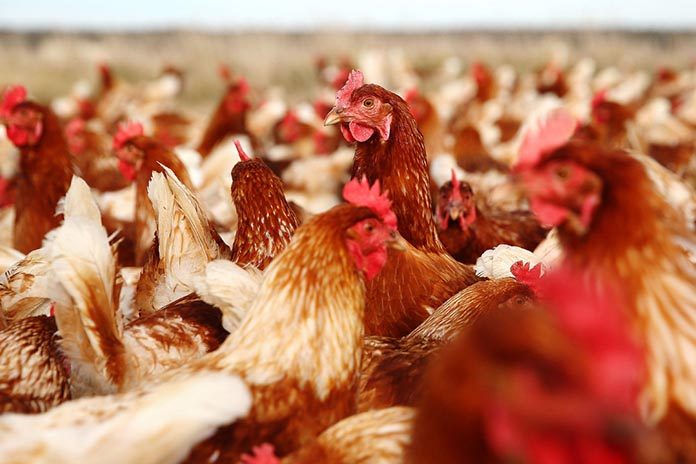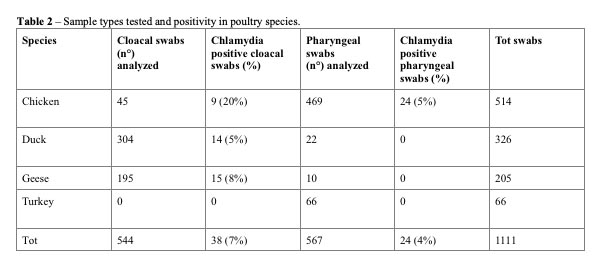
Chlamydia spp. are agents of re-emerging infections in poultry worldwide and deserve attention from a public health perspective due to the well-known zoonotic nature of C. psittaci, the psittacosis- ornithosis’ agent. In 2014, the family Chlamydiaceae has been expanded with two new species, C. avium and C. gallinacea, which have been found so far in pigeons, parrots and poultry in Europe, China, Argentina and North America. The zoonotic potential of these new chlamydial species is under investigation.
The authors undertook a study to investigate the prevalence of C. psittaci and other Chlamydia spp. in the northwestern Italian region of Piedmont, an area highly devoted to the poultry industry. In the context of the 2015 National monitoring plan for Avian Influenza, pharyngeal and cloacal swabs from poultry farms rearing ducks, chickens, turkeys and geese were collected and analyzed with a PCR screening test for the Chlamydiaceae family. Upon an automated nucleic acid extraction with magnetic beads, a real-time PCR targeting the 23S ribosomal RNA gene was performed. Subsequently, all positive samples were characterized by four specie-specific different real-time PCR assays for C. psittaci, C. abortus, C. avium and C. gallinacea.
The raw prevalence of Chlamydia spp. infections was found to be 23% with 20 out of 86 farms testing positive.
The highest prevalences of infection with Chlamydia spp. were found in geese (29.4%; 5/17) and chicken farms (32.3%; 11/34), while a lower prevalence was detected in duck farms (15.4%; 4/26). Interestingly, all turkey farms tested negative at the screening.
C. gallinacea was the most commonly detected chlamydial species, with the highest prevalences in chicken (26.5%; 9/34) and duck farms (11.6%; 3/26), followed by C. psittaci in geese (23.5%; 4/17). Neither C. avium nor C. abortus were detected in any farm.
Based on the results of the study, this year the team started a Research Project on Chlamydia spp. in poultry, supported by the Italian Ministry of Health, to further investigate chlamydial prevalence and associated professional health risks in our region.
Introduction
The family Chlamydiaceae comprises a group of obligate intracellular gram-negative bacteria distributed worldwide, known to cause various forms of disease in animals and humans. According to the most recent taxonomy, the family Chlamydiaceae with the single genus Chlamydia currently contains 11 species: C. abortus, C. avium, C. caviae, C. felis, C. gallinacea, C. muridarum, C. pecorum, C. pneumoniae, C. psittaci, C. suis, and C. trachomatis.
Among them, Chlamydia psittaci is one of the most important zoonotic species from an epidemiological point of view because it is the causative agent of avian chlamydiosis in birds and ornithosis/psittacosis in humans. C. psittaci causes respiratory disease in birds and infections have been demonstrated in at least 465 different bird species, spanning 30 different bird orders. Inhalation of contaminated aerosols originating from feathers, faecal material and respiratory tract exudates are responsible of its zoonotic transfer. Moreover, plumage handling, manipulation of carcasses and tissues of infected birds and, in rare cases, mouth-to-beak contact or biting may also represent a zoonotic risk for people in direct contact with breeding and wild birds, e.g. poultry workers, veterinarians, etc.
The two new species C. avium and C. gallinacea, have been recently detected in breeding and wild birds in different States of Europe (France, Greece, Croatia, Italy, Germany, Poland, and Slovenia) as well as in China; the zoonotic transmission of new Chlamydia species has not been confirmed, but C. gallinacea has been correlated with an atypical pneumonia outbreak occurred in slaughterhouse workers in France in 2009.
Despite the re-emergence of chlamydial infections in poultry in Europe, the public health impact and disease notification for the human sector in most European countries is still very limited. Infact, between 2005 and 2009, the CDC reported only 66 human cases of psittacosis, suggesting an underestimation of the disease in Europe.
Due to the lack of epidemiological data in Italy, both from poultry and human sectors, a pilot study has been started in Piedmont, a northwestern Italian region highly devoted to the poultry industry. Aims of the present study were to assess the circulation of Chlamydia spp. in our territory for the future evaluation of the zoonotic risk for the professionally exposed workers.
Materials and methods
Starting from March 2015 until March 2016, pharyngeal and cloacal swabs from poultry farms rearing ducks, chickens, turkeys and geese were collected for the National monitoring plan for Avian Influenza from free-range, indoor and organic farms. Some industrial indoor farms of turkeys were tested as extraordinary samples in correlation with the 2015 outbreaks of Avian Influenza occurring in poultry in Northern Italy. Pharyngeal and cloacal swabs from poultry farms rearing chickens, ducks, geese and turkeys were collected and analyzed by a PCR screening test for the Chlamydiaceae family.
Upon an automated nucleic acid extraction with magnetic beads using the Maxwell 16 Instrument (Promega), total DNA was eluted in 300 µl of RNase-DNase free water. At first, all samples were screened with a real-time PCR targeting a fragment of the 23S rRNA gene. Species identification was performed on all positive samples by four different real-time PCR assays targeting the ompA gene of C. psittaci and C. abortus, the 16S rRNA gene of C. gallinacea and enoA gene of C. avium. For samples giving a Ct over 35 in the Chlamydiaceae assay, the species determination was not always achievable probably due to a too low copy number of target DNA. We defined those samples as undetermined Chlamydiaceae.
Results and discussion
In the period of study a total of 86 poultry farms were analyzed using the 23S real-time PCR screening for the Chlamydiaceae family. The raw prevalence for Chlamydiaceae was 23% (20/86), with the highest prevalence found in chicken (32.3%, 11/34) and geese farms (29.4%, 5/17). Duck farms had a raw prevalence of 15% (4/26) and all turkey industrial farms tested negative.§
C. gallinacea was the most commonly detected chlamydial species, with the highest prevalence in chicken (26.5%, 9/34) and 12% of prevalence in both duck and geese farms. C. psittaci resulted the most spread in geese farms (24%; 4/17). Neither C. avium nor C. abortus were detected in any farm. Undetermined Chlamydiaceae were found in 1 geese farm out of 17 tested and in 3 out of 34 chicken farms. See Table 1 for detailed number and prevalences in poultry species. As highlighted by other authors C. gallinacea seems to be the endemic chlamydial species in chickens.

Interestingly coinfections with C. psittaci and C. gallinacea were found in one geese and one chicken farms, while in another geese farm the coinfection regarded C. psittaci and an atypical Chlamydiaceae. These results are consistent with previous reports suggesting that mixed infections of C. psittaci with other Chlamydial species are recurrent.
In total 567 pharyngeal and 544 cloacal swabs were analyzed. For duck and geese positivities were found only from cloacal swabs, while for chicken both from pharyngeal (5%; 24/469) and cloacal (20%; 9/45) swabs. See Table 2 for detailed number and prevalences for each sample type in poultry species.
Out of the 20 positive farms, 6 were free range (3 geese and 3 chicken farms), 12 indoor (3 duck, 1 geese and 8 chicken farms) and only two organic (1 duck and 1 geese).
Despite the species high vulnerability to infections, none of the industrial turkey farms resulted infected with Chlamydia spp. In the light of the high level of biosecurity applied in this type of poultry holdings, this result is not surprising. Another hypothesis to be verified might be that antimicrobials to break down the microbial charge were still widespread used in industrial holdings in our region.

Conclusions
Laboratory diagnosis of infections involving strains of Chlamydiaceae family has undergone a remarkable methodological change in the past two decades contributing to the detection of new Chlamydia species. Despite these diagnostic advances and law obligations to evaluate any possible biohazard in the workplace, C. psittaci and C. gallinacea circulation in poultry farms is still underestimated and a specific risk assessment on their zoonotic potential in poultry production remains to be established.
The high prevalences of avian chlamydiosis recorded in this pilot study gave rise to a research project funded by the Italian Ministry of Health on these agents in poultry to investigate chlamydial infection in animals and poultry workers of Piedmont by biomolecular assays. A solid study design and ad-hoc questionnaires on both veterinary and human health will allow to estimate reliable prevalence values and identify the risk factors associated to chlamydial infection at both animal, farm and human level.
From the 6th Mediterranean Poultry Summit, 2018

















